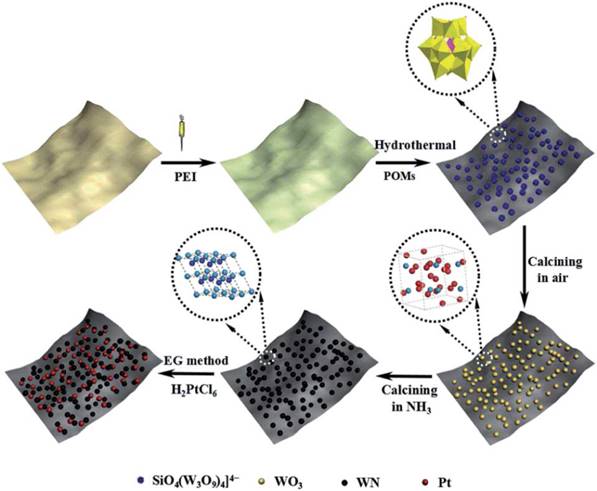Energy Environ. Sci., 2014, 7, 1939–1949

Haijing Yan, Chungui Tian,* Li Sun, Bo Wang, Lei Wang, Jie Yin, Aiping Wu and Honggang Fu*, Small-sized and high-dispersed WN from [SiO4(W3O9)4]4-clusters loading on GO-derived graphene as promising carriers for methanol electro-oxidation. (Energy Environ. Sci., 2014, 7, 1939–1949)
Polyoxometalates (POMs) are known as a famous class of molecular clusters with much diversity in size, composition and function. The most attractive features of POMs are small size close to the nanometer level and stable structure. The high electric charge and good solubility of POM clusters make them easy to coordinate with other substrates to form small-sized and uniform clustersThe characteristics of POMs imply their potential to act as suitable precursor for small-size nitrides. In this paper, we reported a versatile assembly method for the synthesis of small-sized nitrides NPs about 2–3 nm loaded on GO-derived graphene. The WN from H4[SiO4(W3O9)4] (SiW12) clusters was selected as a representative. Graphene, a two-dimensional carbon material, has been demonstrated as a good support for loading functional particles for electrochemical applications. The GO was first modified with positive charged polyethyleneimine (PEI). Then, SiW12 clusters were anchored on PEI-modified GO through a hydrothermal assembling process. Due to the intensive interaction of negatively charged SiW12 anions and positively charged PEI-modified GO, the SiW12 clusters can be anchored on the GO with small size and good dispersion. So, in this paper, we report the synthesis of the smallsized WN nanoparticles (NPs) loading on GO-derived graphene (denoted as graphene for simplicity) by using heteropoly acid H4[SiO4(W3O9)4] (SiW12) clusters as a W source. The SiW12 clusters are anchored on the polyethyleneimine (PEI)-modified GO through a hydrothermal process. After the nitridation with NH3, the small-sized and well dispersed WN NPs of 2–3 nm are obtained. The ternary Pt–WN/graphene catalysts are fabricated by an EG reduction method. The intimate contact and intensive interaction between Pt and WN are verified by TEM, XRD, XPS and XAFS tests. Due to the above characteristics, the Pt–WN/graphene catalyst exhibits a remarkably enhanced activity and durability toward methanol electrocatalytic oxidation. The mass activity of Pt–WN/graphene (531.5 mA mg Pt-1) is 2.45, 2.88 and 3.70 times that of Pt/graphene, Pt/C(JM) and Pt/Vulcan catalysts, respectively. Furthermore, the ternary Pt–WN/graphene catalyst shows excellent resistance to CO poisoning and good stability. The high activityof Pt–WN/graphene is mainly attributed to the enhanced synergistic effect benefited from the intimatecontact and intensive interaction of Pt with WN NPs.
